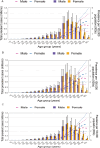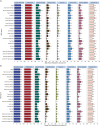Global burden of hypertensive heart disease and attributable risk factors, 1990-2021: insights from the global burden of disease study 2021
- PMID: 40287533
- PMCID: PMC12033261
- DOI: 10.1038/s41598-025-99358-1
Global burden of hypertensive heart disease and attributable risk factors, 1990-2021: insights from the global burden of disease study 2021
Abstract
Hypertensive heart disease (HHD) significantly contributes to global morbidity and mortality, worsened by rising hypertension rates. This study aims to assess the burden of HHD from 1990 to 2021, analyzing prevalence, mortality, and disability-adjusted life years (DALYs) stratified by age, sex, and Sociodemographic Index (SDI). Utilizing data from the Global Burden of Disease 2021 project across 204 countries and 21 regions, the study calculated age-standardized rates and evaluated risk factors for prevention priorities. In 2021, there were 12.5 million HHD cases globally, resulting in 1.332 million deaths and 25.4622 million DALYs. Age-standardized rates were 148.3 for prevalence, 16.3 for deaths, and 301.6 for DALYs per 100,000 people, reflecting increases of 18.2% for prevalence but decreases for deaths (- 22%) and DALYs (- 25.8%) since 1990. Eastern Sub-Saharan Africa recorded the highest prevalence (291.8), while Bulgaria had the highest mortality (103.4) and DALY rates (1739.3). Age-specific trends showed that prevalence, deaths, and DALYs increased with age across genders, and at regional levels, DALYs decreased with higher SDI. Major contributing factors included high systolic blood pressure, metabolic risks, high body-mass index, unhealthy diet, alcohol use, and low fruit and vegetable intake. Despite advances in management, HHD remains a global health concern, especially in low-SDI areas. Efforts focused on modifiable risks, like hypertension control and dietary improvements, are essential to mitigate the burden of HHD.
© 2025. The Author(s).
Conflict of interest statement
Declarations. Competing interests: The authors declare no competing interests. Ethics approval and consent to participate: The University of Washington Institutional Review Board waived the requirement for informed consent to access the GBD data. This research adhered to the Guidelines for Accurate and Transparent Health Estimates Reporting (GATHER).
Figures







Similar articles
-
Trends analysis of the global burden of hypertensive heart disease from 1990 to 2021: a population-based study.BMC Public Health. 2025 Jul 2;25(1):2233. doi: 10.1186/s12889-025-23389-6. BMC Public Health. 2025. PMID: 40604684 Free PMC article.
-
Global prevalence and disability-adjusted life years of hypertensive heart disease: A trend analysis from the Global Burden of Disease Study 2019.J Glob Health. 2024 Aug 30;14:04172. doi: 10.7189/jogh.14.04172. J Glob Health. 2024. PMID: 39212657 Free PMC article.
-
The global magnitude and temporal trend of hypertensive heart disease burden attributable to high sodium intake from 1990 to 2021.Curr Probl Cardiol. 2025 Feb;50(2):102931. doi: 10.1016/j.cpcardiol.2024.102931. Epub 2024 Nov 18. Curr Probl Cardiol. 2025. PMID: 39566868
-
Global, regional, and national burdens of hypertensive heart disease from 1990 to 2019 :A multilevel analysis based on the global burden of Disease Study 2019.Heliyon. 2023 Nov 23;9(12):e22671. doi: 10.1016/j.heliyon.2023.e22671. eCollection 2023 Dec. Heliyon. 2023. PMID: 38213586 Free PMC article.
-
Persistence of severe global inequalities in the burden of Hypertension Heart Disease from 1990 to 2019: findings from the global burden of disease study 2019.BMC Public Health. 2024 Jan 6;24(1):110. doi: 10.1186/s12889-023-17573-9. BMC Public Health. 2024. PMID: 38184560 Free PMC article.
Cited by
-
Simultaneous Assessment of Left Ventricular Volumes and Aortic Valve Annular Dimensions by Three-Dimensional Speckle-Tracking Echocardiography in Healthy Adults from the MAGYAR-Healthy Study-Is There a Relationship?Life (Basel). 2025 May 6;15(5):742. doi: 10.3390/life15050742. Life (Basel). 2025. PMID: 40430170 Free PMC article.
References
-
- Westaby, J. D. et al. Characterisation of hypertensive heart disease: Pathological insights from a sudden cardiac death cohort to inform clinical practice. J. Hum. Hypertens.36(3), 246–253. 10.1038/s41371-021-00507-6 (2022). - PubMed
MeSH terms
Grants and funding
LinkOut - more resources
Full Text Sources
Medical

